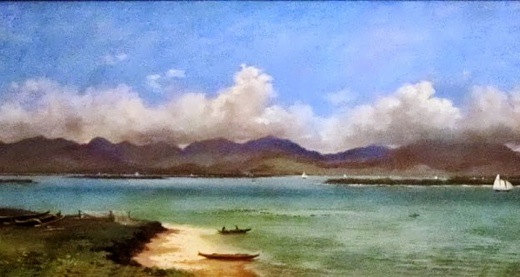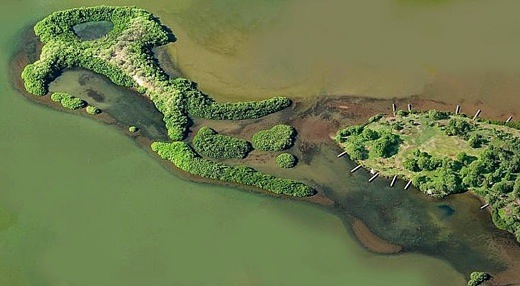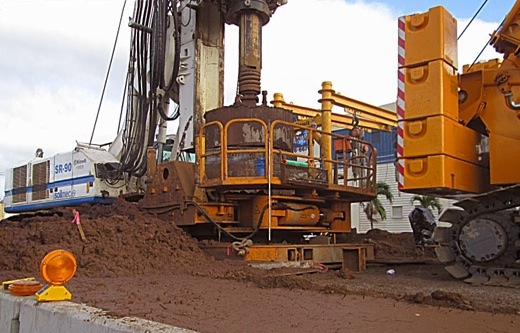SUBHEAD: HART Rail hitting karst water, sea caves polluting critical wetlands and damaging cultural sites.
By John Bond on 11 January 2015 for Kanehili Cultural Hui -
(http://honouliuli.blogspot.com/2015/01/Hart-rail-disaster-hitting-Oahu.html)

Image above: Above, "Pearl Harbor" as it was painted in 1898. Pearl Harbor is a vast estuary of ancient coral reef coastal habitats which native Hawaiians made extensive use of. From original article.
[IB Publisher's note: The article below is only a brief summary of the likely impact of currently planned mass transit development on the Ewa Plain near Pearl Harbor. For a more detailed and comprehensive article please see the original article. It is our position that the Ewa Plain (and Pearl Harbor), along with the Mana Plain on Kauai, are historically the two most critical wetlands in the Hawaiian chain. Both environments have been greatly compromised by Big Ag and the military and will be further damaged with current plans.]
West Oahu's greatest natural apocalypse is unfolding, with hundreds of 8 foot in diameter, 200 foot deep drill bores, the ancient karst water, sea caves and wetlands are being fractured and polluted, then to be followed by a major new asphalt and concrete city based around three huge HART (Honolulu Authority Rapid Transit) Rail Transit developments.
The already fragile Ewa Plain ecosystem based on natural clean water will be destroyed.

Image above: Laulaunui Island in the rich wetlands of Puuloa area and nearby Ewa Plain. From original article.
Pearl Harbor was originally an extensive shallow ancient coral reef embayment called Wai Momi meaning “Waters of Pearl” or Puuloa meaning “long hill” by Hawaiians. The large uplands of inland Oahu fed massive amounts of surface and subsurface fresh nutrient rich water into the Pearl River which spawned great quantities of pearl laden oysters and teeming sea life.
Fresh spring water is especially important in the propagation of plant and sea life and the food chains they create- from limu on up to large pelagic fish.
Surface and ground waters are very susceptible to contamination from pollutants.
Contaminants can reach ground water quickly through fractured rock formations or sinkholes in karst areas, such as that found in Ewa. Ground water is more sensitive to contamination in these areas because runoff may pass directly into the subsurface with little if any infiltration through the soil, a process that typically filters at least some pollutants.
The Ewa Karst is the largest of several karsts on Oahu, but possibly the least studied (in the Hawaiian Islands and especially the United States.) Many State and even some Federal agencies refused to recognize that Ewa has a karst subsurface water system. Most people in Hawaii have never heard of karst or that a large number of the population live on an ancient coral reef.

Image above: Piledriving operations for HART project on Ewa Plain threatens karst formations critical to environment and wetlands integrity. From original article.
The HART Rail pylons to support the system will be 8 foot in diameter and go down as far as 150-200 feet deep. The hundreds these pylons required are going destroy ancient lava tubes, karst waterways and the sacred wahi pana cave sites of native Hawaiians.
Drilling hundreds of 8 foot diameter deep bores below the surface of Pearl Harbor waters will greatly endangering an entire ecosystem. It contaminate subsurface waters and exposed them to modern street and machinery pollutants.
The eight foot in diameter Waipahu deep boring rail column sites have been a consistent problem for the Kiewit construction company because they are hitting large amounts of underground water channels.
The entire ancient history (and plantation era history) is loaded with springs popping out of the ground everywhere. For agriculture and fish ponds these were ideal conditions. Today everything is being covered in concrete and asphalt.
An entire bountiful ecosystem and cultural heritage being destroyed by land developers.
Off the Ewa shore are the numerous huge circular holes in the still living reef where vast amounts of upland fresh water has run through the ancient Karst reef and out into the sea through underground caves.
These huge fresh water outlets create excellent fishing grounds and feed nutrients into the sea that create ideal spawning conditions.
These once fantastic ecosystems fed native Hawaiians for a thousand years however the waters are increasingly being diverted, cut off and polluted by up stream development on the Ewa Plain.
.
By John Bond on 11 January 2015 for Kanehili Cultural Hui -
(http://honouliuli.blogspot.com/2015/01/Hart-rail-disaster-hitting-Oahu.html)

Image above: Above, "Pearl Harbor" as it was painted in 1898. Pearl Harbor is a vast estuary of ancient coral reef coastal habitats which native Hawaiians made extensive use of. From original article.
[IB Publisher's note: The article below is only a brief summary of the likely impact of currently planned mass transit development on the Ewa Plain near Pearl Harbor. For a more detailed and comprehensive article please see the original article. It is our position that the Ewa Plain (and Pearl Harbor), along with the Mana Plain on Kauai, are historically the two most critical wetlands in the Hawaiian chain. Both environments have been greatly compromised by Big Ag and the military and will be further damaged with current plans.]
West Oahu's greatest natural apocalypse is unfolding, with hundreds of 8 foot in diameter, 200 foot deep drill bores, the ancient karst water, sea caves and wetlands are being fractured and polluted, then to be followed by a major new asphalt and concrete city based around three huge HART (Honolulu Authority Rapid Transit) Rail Transit developments.
The already fragile Ewa Plain ecosystem based on natural clean water will be destroyed.

Image above: Laulaunui Island in the rich wetlands of Puuloa area and nearby Ewa Plain. From original article.
Pearl Harbor was originally an extensive shallow ancient coral reef embayment called Wai Momi meaning “Waters of Pearl” or Puuloa meaning “long hill” by Hawaiians. The large uplands of inland Oahu fed massive amounts of surface and subsurface fresh nutrient rich water into the Pearl River which spawned great quantities of pearl laden oysters and teeming sea life.
Fresh spring water is especially important in the propagation of plant and sea life and the food chains they create- from limu on up to large pelagic fish.
Surface and ground waters are very susceptible to contamination from pollutants.
Contaminants can reach ground water quickly through fractured rock formations or sinkholes in karst areas, such as that found in Ewa. Ground water is more sensitive to contamination in these areas because runoff may pass directly into the subsurface with little if any infiltration through the soil, a process that typically filters at least some pollutants.
The Ewa Karst is the largest of several karsts on Oahu, but possibly the least studied (in the Hawaiian Islands and especially the United States.) Many State and even some Federal agencies refused to recognize that Ewa has a karst subsurface water system. Most people in Hawaii have never heard of karst or that a large number of the population live on an ancient coral reef.

Image above: Piledriving operations for HART project on Ewa Plain threatens karst formations critical to environment and wetlands integrity. From original article.
The HART Rail pylons to support the system will be 8 foot in diameter and go down as far as 150-200 feet deep. The hundreds these pylons required are going destroy ancient lava tubes, karst waterways and the sacred wahi pana cave sites of native Hawaiians.
Drilling hundreds of 8 foot diameter deep bores below the surface of Pearl Harbor waters will greatly endangering an entire ecosystem. It contaminate subsurface waters and exposed them to modern street and machinery pollutants.
The eight foot in diameter Waipahu deep boring rail column sites have been a consistent problem for the Kiewit construction company because they are hitting large amounts of underground water channels.
The entire ancient history (and plantation era history) is loaded with springs popping out of the ground everywhere. For agriculture and fish ponds these were ideal conditions. Today everything is being covered in concrete and asphalt.
An entire bountiful ecosystem and cultural heritage being destroyed by land developers.
Off the Ewa shore are the numerous huge circular holes in the still living reef where vast amounts of upland fresh water has run through the ancient Karst reef and out into the sea through underground caves.
These huge fresh water outlets create excellent fishing grounds and feed nutrients into the sea that create ideal spawning conditions.
These once fantastic ecosystems fed native Hawaiians for a thousand years however the waters are increasingly being diverted, cut off and polluted by up stream development on the Ewa Plain.
.
No comments :
Post a Comment